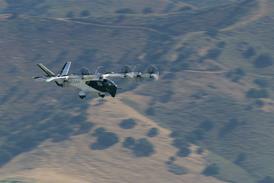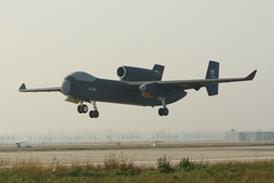VisionAire is working on plans for a family of small, all-composite, single-engined jet aircraft which would form a follow-on to its Vantage business jet.
Tom Stark, president emeritus of VisionAire and senior vice-president of its Future Works subsidiary, says that the initial family of a two-seat trainer and a four-to-six-seater would be powered by the Williams FJX-2 engine, and would be based on a common wing.
The trainer, as now conceived, would be a tandem-seat, shoulder-wing design looking "-as if somebody had taken a sanding block to a British Aerospace Harrier", says Stark. He adds that, although the new aircraft could use a forward-swept wing if necessary for centre-of-gravity reasons, it would not be as radical-looking as the V-JET technology demonstrator on which the Williams engine is now being tested.
Wing-commonality for the family would be possible because a wing large enough to give the trainer its low wing-loading and stall-speed would be adequate for the faster-landing, high-wing-loading larger machine.
The company plans to complete a full-scale, high-fidelity mock-up of the aircraft in about one year's time to test market reaction.
Meanwhile, VisionAire hopes to select, within a month, the company which will perform the production-design work necessary to turn the Vantage from a proof-of-concept aircraft into the first of two definitive prototypes by the end of 1998. The current aircraft was built by Scaled Composites, one of the five companies now discussing the production-design work with VisionAire.
VisionAire has abandoned the filament-wound fuselage design planned for the Vantage, and will use conventional composite lay-up, which the company is more confident can be certificated within its planned timescale. Scaled Composites filament-winding technology was used to produce the proof-of-concept aircraft.
The design change, to "minimise risk", has delayed the first flight of a certification-test aircraft by seven months, to December 1998. US certification is scheduled for the fourth quarter of 1999.
Michael Krupp, the company's experimental-flight-test chief, says that the definitive aircraft will be 150-200mm longer than the first aircraft and, unlike that, will be pressurised. It will have engine-bleed-air de-icing on the wing, and a horizontal tail of increased dihedral and size.
The landing gear will have shorter struts and a new two-piece door design allowing the forward halves of the doors to be used independently of the gear as speed brakes.
Krupp says that the Vantage has amassed more than 133h of flying in 170 flights. The company claims paid-deposit orders for 103 Vantages, with an order backlog worth $150million.
Manufacturing is due to start at its new Ames, Ohio plant in the middle of 1998.
Source: Flight International























